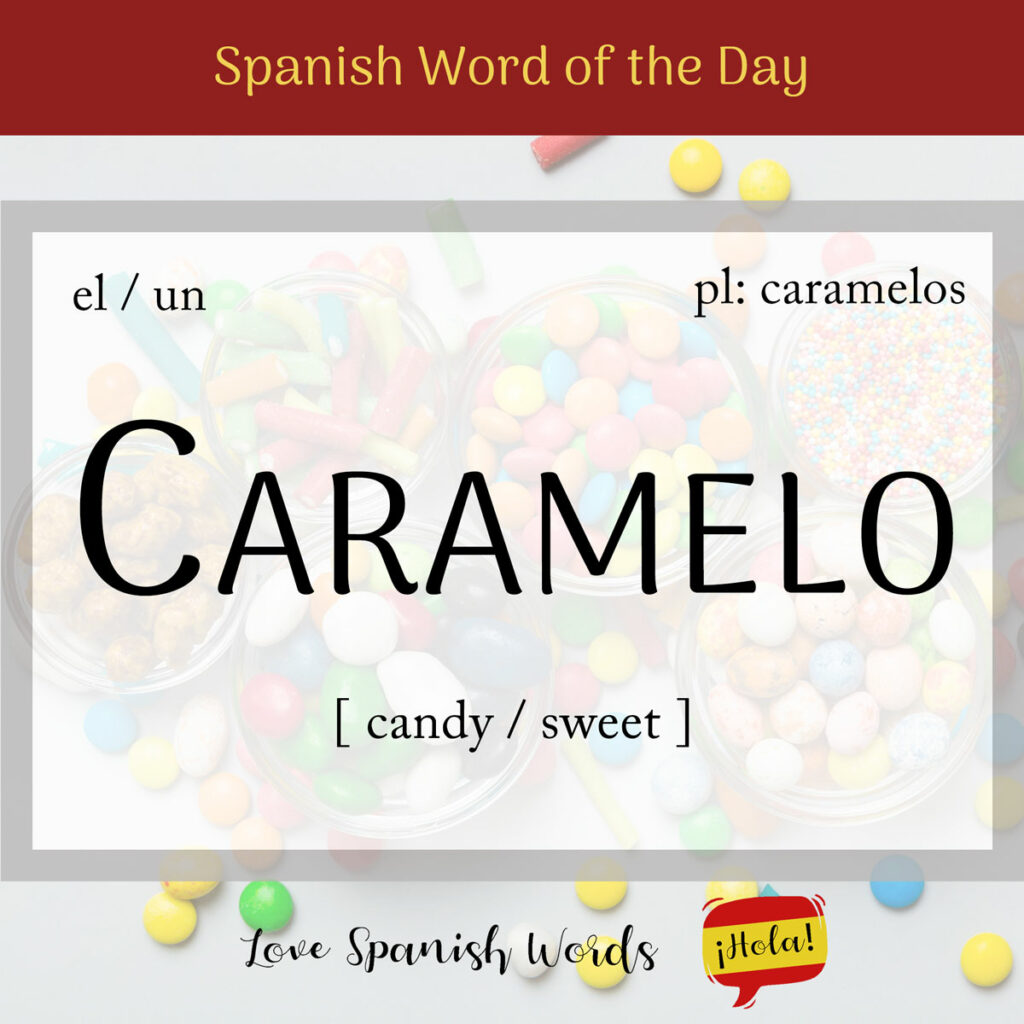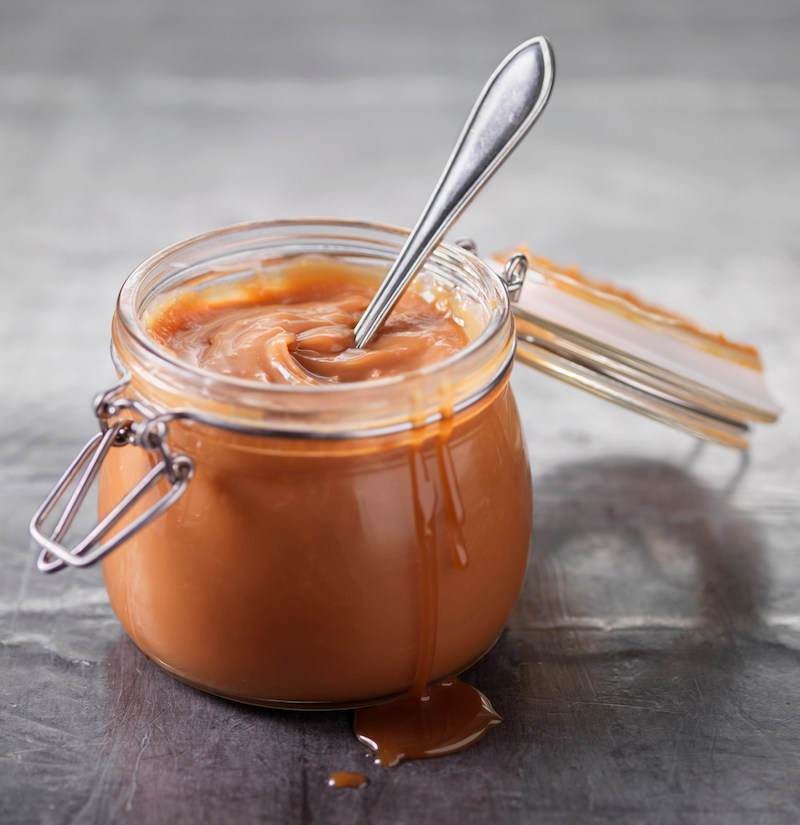At this moment, I’m savouring a delightful custard and rhubarb caramelo (candy / sweet), and I couldn’t help but think to myself: what a delectable Spanish word of the day it could be!
Latin American Pronunciation
European Pronunciation

The word was borrowed from the Portuguese caramelo, which most likely derives from Late Latin calamellus.
Caramelo is a masculine noun, so it takes the following definite and indefinite articles:
- el caramelo = the candy
- los caramelos = the candies
- un caramelo = a candy
- unos caramelos = some candies
If you decide to let your child have a piece of candy – and believe me, it’s inevitable – it’s important to choose a caramelo masticable (chewy candy) over a caramelo macizo (hard candy) for their safety. Regardless of age, it’s better to chupar (suck) on a piece of candy rather than masticar (chew) it to protect your dientes (teeth). And don’t forget to throw the envoltorio (candy wrapper) in the garbage bin!
A los niños les gustan los caramelos.
Children love candies.
You may be wondering if caramelo can also mean caramel or caramel sauce, and the answer is yes! A very popular kind of caramel sauce in Latin American and Spain is the rich and creamy dulce de leche, which is made by heating sweetened milk.


Speaking of the word dulce, did you know that it is a possible synonym for caramelo? The difference is that dulce is more general and can include cakes, pastries, and anything else that can be classified as sweet. Dulce is also an adjective that means sweet.
Now let’s take a quick look at what our contributors have to say about the most famous candies in their respective countries!
🇪🇸 Joanna & Daisy (Spain):
In Spain caramelos are more commonly known by the colloquial term chuches and they play a very large part in Spanish culture. In every village and town you will find at least one quiosco (kiosk) and shops dedicated simply to these sweets treats, helados (ice creams) and savoury snacks. These shops and kiosks will often be open until very late at night, as the family is out for a paseo (walk) they will visit to stock up on chuches for the kids to enjoy while they play.
The most famous Spanish chuches are probably the Chupa Chups, this is the brand name for the original lollipop or chupete and chupa chup would be a more commonly heard name for a lollipop generically. The name comes from the verb chupar (to suck).
Another popular chuche is chicle (chewing gum), the name of this comes from the natural ingredient chicle traditionally used in the making of gum dating back to Mayan times in Latin America. Nowadays most companies will use a synthetic alternative ingredient in their gum.
A favourite with Daisy when she was small was a combination of the above, a chupa chup with chicle in the centre!
🇲🇽 Carolina (Mexico):
You might already be familiar with Mexico’s fame for spicy food, so it’s no surprise that candies in Mexico are also infused with spicy flavors. Kids grow up eating them, and let’s just say as adults Mexicans love their picante (spice).
Many of the spicy candies in Mexico are covered in chilli powder or are tamarind-based. Some tamarind-based ones include Pelon Pelo Rico, Pulparindo, Skwinkles, Rellerindos, and Karla Cups. Then we have Chamoy which is a candy and salsa used on chips and fresh fruit. Candies covered in spicy chilli powder include lollipops or paletas, such as the elote (corn), sandía (watermelon), and mango (mango) ones. Sweet chilli candy is also used on artisanal and traditional candies such as fruits, dried fruits, nuts, chilli, and seeds. A very popular sugary and salty chilli powder called Tajín is used on snacks such as fruits and chips but also served on the rims of beer mugs for a refreshing Michelada.
Non-spicy candy in Mexico includes ones made from a unique dulce de leche (milk candy) called cajeta. Many small hard and soft candies have this flavour but so do many pastries and ice creams. The most non-spicy famous candy in Mexico is the Mazapan. This is a sweet and salty mix of peanut candy that crumbles into dry powder at the first bite. It’s so popular it has a national day in the country. The second most famous sweet candy is the Duvalin, which is a pudding-like cream with vanilla, strawberry, and chocolate flavors. Would you taste spicy candy or do you prefer to stick to sweet candy?
🇨🇴 Jenn & Estefanía (Colombia):
In Colombia, our abundance of sugar cane and cacao reflects our love for sweet treats. Among these, Chocoramo stands out as a beloved favourite, combining cake and chocolate into a perfect blend. Jet Chocolate is another iconic candy, celebrated for its smooth milk chocolate and collectible stickers included with each bar. Colombina’s Bon Bon Bum, a fruity lollipop with a bubblegum center, is everyone’s favourite. And Coffee Delight candies capture the essence of Colombia’s renowned coffee, offering a rich, aromatic experience in a small, chewy form.

Important: Caramelo shouldn’t be confused with the similar-sounding caramillo, which has various meanings including panpipes, saltwort and even gossip! What is worth mentioning is that the two words are likely doublets, or in other words, two words of the same derivation (in this case, the Latin calamellus) but with different meanings.
Much like the English word sweetie, caramelo can be used as a term of endearment for someone with a sweet temperament.

Spanish idiomatic expressions featuring ‘caramelo’
A punto de caramelo
Literal translation: at the point of candy
English meaning: ripe for the picking, primed for, ready
Feliz como un niño con un caramelo
Literal translation: as happy as a kid with a candy
English meaning: to be as happy as a clam

